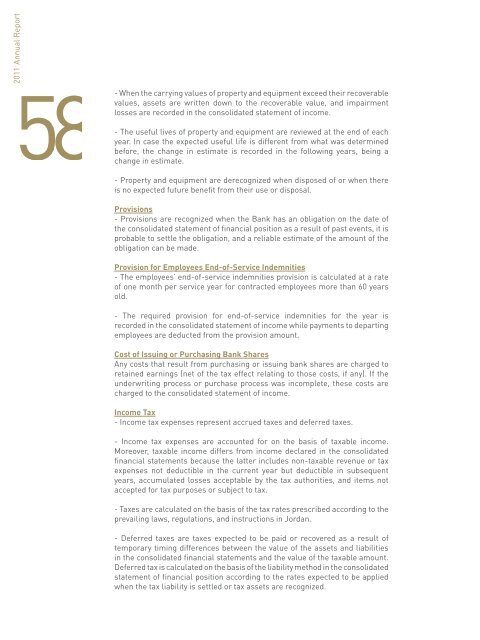Annual Report 2011 - Jordan Investment and Finance bank
Annual Report 2011 - Jordan Investment and Finance bank
Annual Report 2011 - Jordan Investment and Finance bank
You also want an ePaper? Increase the reach of your titles
YUMPU automatically turns print PDFs into web optimized ePapers that Google loves.
58-When the carrying values of property <strong>and</strong> equipment exceed their recoverablevalues, assets are written down to the recoverable value, <strong>and</strong> impairmentlosses are recorded in the consolidated statement of income.- The useful lives of property <strong>and</strong> equipment are reviewed at the end of eachyear. In case the expected useful life is different from what was determinedbefore, the change in estimate is recorded in the following years, being achange in estimate.- Property <strong>and</strong> equipment are derecognized when disposed of or when thereis no expected future benefit from their use or disposal.Provisions- Provisions are recognized when the Bank has an obligation on the date ofthe consolidated statement of financial position as a result of past events, it isprobable to settle the obligation, <strong>and</strong> a reliable estimate of the amount of theobligation can be made.Provision for Employees End-of-Service Indemnities- The employees’ end-of-service indemnities provision is calculated at a rateof one month per service year for contracted employees more than 60 yearsold.- The required provision for end-of-service indemnities for the year isrecorded in the consolidated statement of income while payments to departingemployees are deducted from the provision amount.Cost of Issuing or Purchasing Bank SharesAny costs that result from purchasing or issuing <strong>bank</strong> shares are charged toretained earnings (net of the tax effect relating to those costs, if any). If theunderwriting process or purchase process was incomplete, these costs arecharged to the consolidated statement of income.Income Tax- Income tax expenses represent accrued taxes <strong>and</strong> deferred taxes.- Income tax expenses are accounted for on the basis of taxable income.Moreover, taxable income differs from income declared in the consolidatedfinancial statements because the latter includes non-taxable revenue or taxexpenses not deductible in the current year but deductible in subsequentyears, accumulated losses acceptable by the tax authorities, <strong>and</strong> items notaccepted for tax purposes or subject to tax.- Deferred tax assets are reviewed as of the date of the consolidated financialstatements, <strong>and</strong> reduced in case it is expected that no benefit will arisetherefrom, partially or totally.Accounts Managed on Behalf of ClientsThis item represents the accounts managed by the Bank on behalf of itsclients <strong>and</strong> is not part of the Bank’s assets. The fees <strong>and</strong> commissions formanaging these accounts are shown in the consolidated statement of income.Furthermore, a provision is taken against the decline in the value of capitalguaranteedportfolios managed on behalf of clients.OffsettingFinancial assets <strong>and</strong> financial liabilities are offset, <strong>and</strong> the net amount isreflected in the consolidated statement of financial position only when there arelegal rights to offset the recognized amounts, the Bank intends to settle themon a net basis, or assets are realized <strong>and</strong> liabilities settled simultaneously.Realization of Income <strong>and</strong> Recognition of Expenses- Interest income is realized <strong>and</strong> expenses are recognized using the effectiveinterest rate method, except for interest <strong>and</strong> commission on non-performingloans which are not recognized as revenue but recorded in the interest <strong>and</strong>commission in suspense account until they are received in cash.- Expenses are recognized on the accrual basis.- Commission is recorded as revenue when the related services are provided.- Dividends are recorded when realized (decided upon by the General Assemblyof Shareholders).Recognition of Financial AssetsFinancial assets are recognized on the trading date which is the date the Bankcommits itself to purchase or sell the financial assets.Financial Derivatives <strong>and</strong> Hedge AccountingFor hedge accounting purposes, financial derivatives are stated at fair value.Hedges are classified as follows:- Fair value hedge:Hedge for the change in the fair value exposures of the Bank’s assets <strong>and</strong>liabilities.59Notes to the consolidtaed financial statements- Taxes are calculated on the basis of the tax rates prescribed according to theprevailing laws, regulations, <strong>and</strong> instructions in <strong>Jordan</strong>.- Deferred taxes are taxes expected to be paid or recovered as a result oftemporary timing differences between the value of the assets <strong>and</strong> liabilitiesin the consolidated financial statements <strong>and</strong> the value of the taxable amount.Deferred tax is calculated on the basis of the liability method in the consolidatedstatement of financial position according to the rates expected to be appliedwhen the tax liability is settled or tax assets are recognized.When the conditions of effective fair value hedge are met, the resulting gain orloss from re-measuring the fair value hedge is recognized in the consolidatedstatement of income.When the conditions of effective portfolio hedge are met, the gain or lossresulting from the revaluation of the hedging instrument at fair value as wellas the change in the fair value of the assets or liabilities portfolio are recordedin the consolidated statement of income for the same period.



